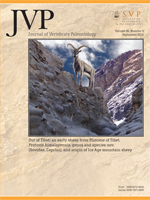Modern wild sheep, Ovis, is widespread in the mountain ranges of the Caucasus through Himalaya, Tibetan Plateau, Tianshan-Altai, eastern Siberia, and the Rocky Mountains in North America. In Eurasia, fossil sheep are known at a few Pleistocene sites in North China, eastern Siberia, and western Europe, but are so far absent from the Tibetan Plateau. We describe an extinct sheep, Protovis himalayensis, gen. et sp. nov., from the Pliocene of the Zanda Basin in western Himalaya. Smaller than the living argali, this new form shares with Ovis posterolaterally arched horncores and partially developed sinuses and possesses several transitional characters leading to Ovis. Protovis likely subsisted on C3 plants, which are the dominant vegetation in the Zanda area during the Pliocene. With the discovery of this new genus and species, we extend the fossil record for the sheep clade into the Pliocene of the Tibetan Plateau, consistent with our previous out-of-Tibet hypothesis. Ancestral sheep in the Pliocene were presumed adapted to high altitude and cold environments, and during the Ice Age, sheep became anatomically modern and dispersed outside of the Tibetan Plateau. Both this new fossil datum and the existing molecular phylogeny suggest that the Tibetan Plateau, possibly including Tianshan-Altai, represents the ancestral home range(s) of mountain sheep and that these basal stocks were the ultimate source of all extant species. Most sheep species survived along their Pleistocene route of dispersal, offering a highly consistent pattern of zoogeography.
How to translate text using browser tools
1 September 2016
Out of Tibet: An Early Sheep from the Pliocene of Tibet, Protovis himalayensis, gen. et sp. nov. (Bovidae, Caprini), and Origin of Ice Age Mountain Sheep
Xiaoming Wang,
Qiang Li,
Gary T. Takeuchi
ACCESS THE FULL ARTICLE






